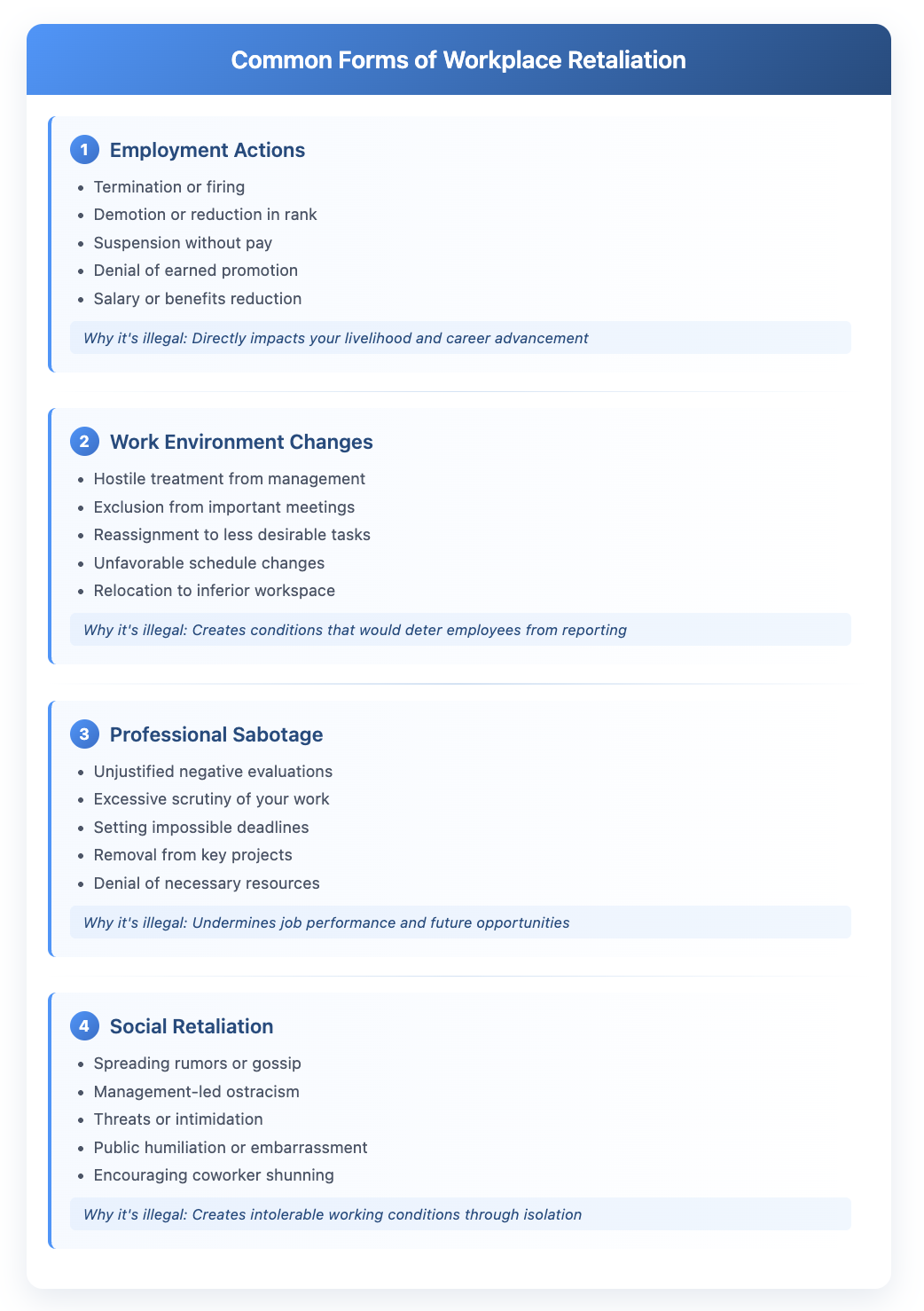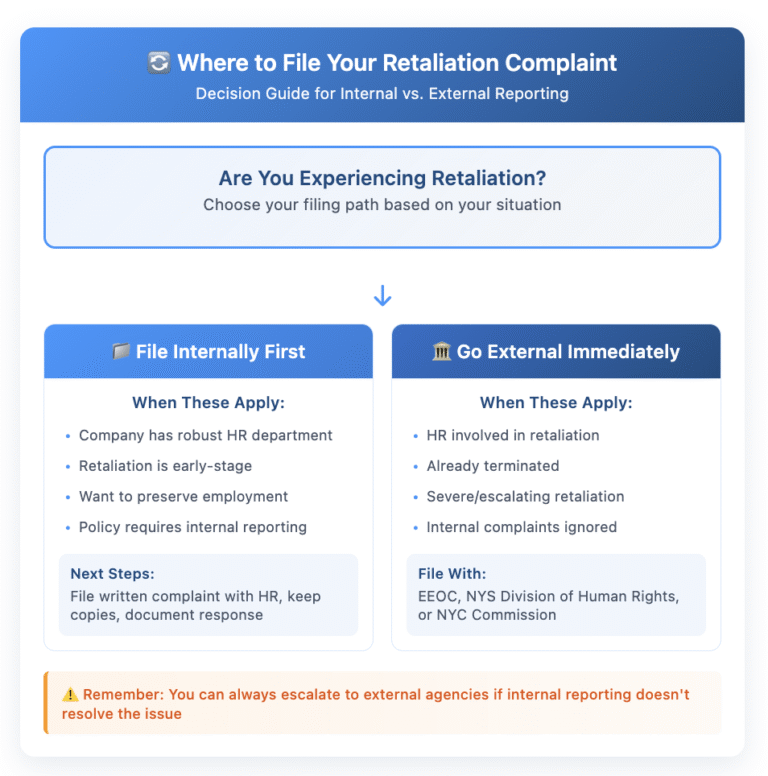You reported sexual harassment because it was the right thing to do. Now your work life has become a nightmare of bad performance reviews, schedule changes, and cold shoulders from management. If this sounds familiar, you’re experiencing retaliation – and federal and New York law are on your side.
Here’s what you need to know: retaliation for reporting sexual harassment is just as illegal as the harassment itself. In fact, retaliation claims now make up nearly 56% of all EEOC charges, making it the most common type of discrimination complaint filed with the agency.
Disclaimer: This article provides general information for informational purposes only and should not be considered a substitute for legal advice. It is essential to consult with an experienced employment lawyer at our law firm to discuss the specific facts of your case and understand your legal rights and options. This information does not create an attorney-client relationship.
What Counts as Retaliation Under the Law
Retaliation isn’t always as obvious as getting fired the day after filing a complaint. The legal standard is any “materially adverse action” that would discourage a reasonable employee from reporting harassment.
This covers a surprisingly wide range of workplace actions. Your employer can’t punish you for reporting harassment, participating in an investigation, or supporting a coworker’s complaint – even if the original harassment claim doesn’t pan out.
The Protected Activities That Shield You
Before we dive into what retaliation looks like, let’s be clear about what activities protect you from retaliation:
Internal Reporting – Complaining to HR, management, or using your company’s harassment reporting system all count as protected activities. You don’t need to use magic legal words; saying “this feels wrong” or “this makes me uncomfortable” is enough.
External Reporting – Filing a charge with the EEOC or the New York State Division of Human Rights puts you squarely in the protected category. The same goes for filing a lawsuit or contacting an attorney about potential legal action.
Participation and Support – Being a witness in someone else’s harassment investigation, providing testimony, or even just refusing to lie about what you saw – all are protected. The law recognizes that harassment thrives in silence, so it protects those who speak up in any capacity.
Common Forms of Workplace Retaliation
Let’s get specific about what retaliation actually looks like in the workplace. Some forms are obvious, others are subtle enough that you might question whether you’re overreacting (spoiler: you’re probably not).

The Timeline: When Retaliation Becomes Legally Actionable
Timing matters in retaliation cases. Courts look at the temporal proximity between your protected activity and the adverse action. If you’re fired two days after filing an EEOC complaint, that timing alone might be enough to prove retaliation.
But retaliation can also be a slow burn. Maybe nothing happens for a month, then suddenly you’re getting written up for being two minutes late when others stroll in whenever they want.
The Legal Timeline You Need to Know
Understanding deadlines is critical for protecting your rights. Missing these dates could mean losing your right to sue, regardless of how strong your case is.

These aren’t suggestions – they’re hard deadlines. The clock starts ticking from each individual act of retaliation, not from when you first reported harassment.
Building Your Retaliation Case: The Evidence That Matters
Documentation is your best friend in a retaliation case. Every email, every changed schedule, every suddenly critical performance review – it all matters. But knowing what to document and how to do it effectively makes the difference between a strong case and a he-said-she-said situation.
The Paper Trail: What to Document
Start documenting everything the moment you make your harassment complaint. Actually, start before if possible. Having a baseline of your normal treatment makes the retaliation stand out clearly.
Your Performance History – Gather your past performance reviews, commendations, and emails praising your work. This establishes you as a good employee before the retaliation started.
The Complaint Itself – Keep copies of every complaint you made, whether verbal (document date, time, who was present) or written. If you complained verbally, follow up with an email “confirming our conversation about…”
The Changes – Document every adverse action with dates, times, and witnesses. Screenshot schedule changes, save critical emails, and photograph workspace changes. Note patterns – are you the only one getting this treatment?
Creating Unshakeable Documentation
Here’s how to document retaliation in a way that holds up legally:

Your Legal Protections: Federal, State, and City Laws
You’re protected by multiple layers of law, each with its own advantages. Understanding these differences helps you and your attorney choose the best legal strategy.
Federal Protection: Title VII
Title VII of the Civil Rights Act makes retaliation illegal nationwide. The Supreme Court has repeatedly strengthened these protections, recognizing that fear of retaliation is often the biggest barrier to reporting harassment.
The Burlington Northern standard, established by the Supreme Court in 2006, expanded protection beyond just workplace actions. Under this standard, even actions outside work (like filing false criminal charges) can constitute illegal retaliation if they’d deter a reasonable person from complaining.
New York State Human Rights Law (NYSHRL)
New York’s state law offers broader protection than federal law. Recent amendments have made it even stronger, eliminating the “severe or pervasive” standard and making it easier to prove retaliation.
The NYSHRL covers all employers in New York, regardless of size. It also allows for punitive damages and attorneys’ fees, making it a powerful tool against retaliating employers.
New York City Human Rights Law (NYCHRL)
If you work in NYC, you have the strongest anti-retaliation protections in the country. The NYCHRL is interpreted more liberally than state or federal law, meaning more actions qualify as illegal retaliation.
Under the NYCHRL, your employer must prove their actions were motivated by legitimate, non-retaliatory reasons. This burden-shifting makes it easier for employees to win retaliation cases.
The Retaliation Trap: When Employers Make It Worse
Some employers, in their eagerness to avoid a harassment lawsuit, stumble into something worse – a retaliation claim. Even if the original harassment complaint is weak or unproven, retaliation creates an entirely separate legal violation.
This is why retaliation claims often succeed even when the underlying harassment claim fails. The law protects your right to complain in good faith, even if an investigation doesn’t substantiate your original complaint.
Red Flags That Strengthen Your Case
Certain employer behaviors practically scream retaliation to judges and juries:
Timing That’s Too Convenient – Suddenly discovering “performance issues” days after you complain? Courts see right through this.
Deviation from Policy – When established procedures suddenly don’t apply to you, that’s evidence of discriminatory treatment.
The Paper Trail That Wasn’t – No documentation of these supposed performance problems before your complaint? That gap speaks volumes.
Inconsistent Treatment – Others are doing the same things without consequences, while you’re written up? That disparity is powerful evidence.
Protecting Yourself While the Case Proceeds
Fighting retaliation while still working at the company requires a strategy. You need to protect your job, your mental health, and your legal case simultaneously.
Survival Strategies for the Workplace
Continue Performing Well – Don’t give them legitimate reasons to discipline you. Document your continued good performance.
Follow Procedures – Use company policies for everything. Request accommodations in writing. Take sick days properly. Don’t let frustration make you sloppy.
Build Support Networks – Connect with coworkers who witness the retaliation. Their testimony could be crucial later.
Consider Your Options – Sometimes staying and fighting is right. Sometimes, finding new employment while pursuing your case is better for your mental health and career.
When to Escalate: Internal vs. External Complaints

The Legal Process: What to Expect
Understanding the legal process helps you make informed decisions about your case. Each step has its purpose, timeline, and potential outcomes.
Filing with the EEOC or State Agencies
Your first step is usually filing an administrative charge. This isn’t a lawsuit – it’s a prerequisite to filing one. The agency investigates your claim and attempts to mediate a resolution.
The EEOC process typically takes 6-10 months. During this time, they’ll request documents from your employer, possibly interview witnesses, and determine whether there’s reasonable cause to believe retaliation occurred.
From Complaint to Resolution
Most retaliation cases settle before trial. This isn’t giving up – it’s often the smartest path to compensation and closure. Settlements can include:
- Back pay for lost wages
- Front pay for future losses
- Compensation for emotional distress
- Policy changes at the company
- Neutral references
- Attorneys’ fees
If settlement isn’t possible, litigation follows. This means depositions, document discovery, and potentially a trial. The process can take 1-3 years, but strong retaliation cases often settle once employers see the evidence stacked against them.
Take Action: Your Next Steps
If you’re experiencing retaliation for reporting sexual harassment, time is not on your side. Evidence disappears, witnesses forget, and deadlines pass. Here’s your action plan:
Immediately:
- Start documenting everything
- Save all relevant emails and documents externally
- Make notes of verbal conversations
- Identify potential witnesses
Within Days:
- Consult with an employment attorney
- Review your employee handbook
- Check your state’s recording laws if considering recording conversations
- Secure your personal items at work
Within Weeks:
- File internal complaints if appropriate
- Seek mental health support if needed
- Consider filing with the EEOC or a state agency
- Continue performing your job well despite the situation
Retaliation for reporting sexual harassment is illegal, full stop. You don’t have to accept it, work through it, or hope it gets better. The law provides powerful tools to fight back and hold employers accountable.
At Nisar Law Group, we understand the courage it takes to stand up against workplace harassment and the additional strength required to fight retaliation. If you’re facing retaliation for reporting sexual harassment, don’t wait for it to get worse. Contact us for a consultation to discuss your rights, your options, and the best path forward for your specific situation.
Remember: speaking up about harassment is protected by law. When employers retaliate, they’re not just violating your rights – they’re breaking federal, state, and city laws designed specifically to protect employees like you. You’ve already shown courage by reporting harassment. Now let us help you protect your career and hold your employer accountable.


